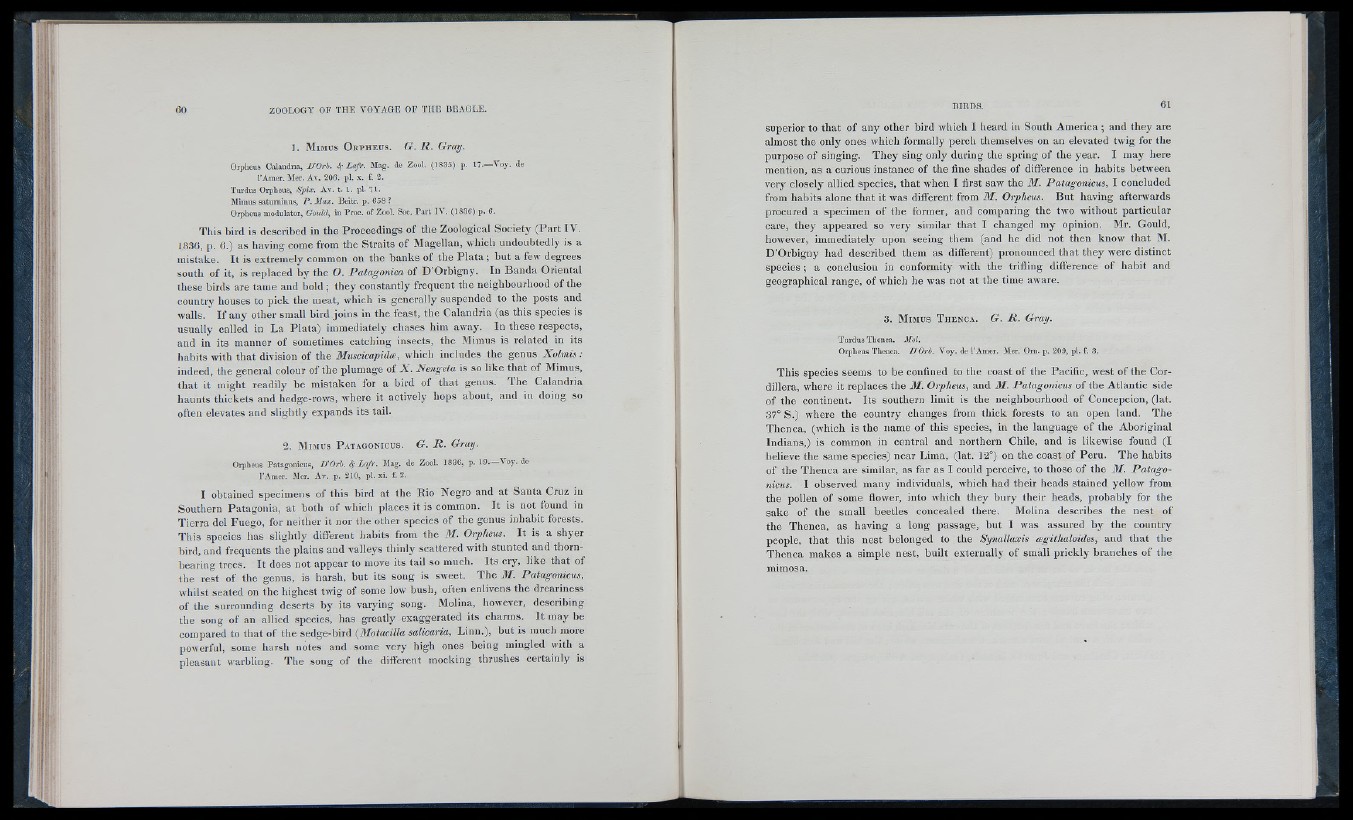
] . M im u s O r p h e u s . G . l i . Gray.
Orpheus Calaudna, jyOrh. Sf Lafi-. Mag. de Zool. (1835) p. 17— Voy. de
I’Anicr. Mer. Av. 206. pi. x. f. 2.
Turdus Orpheus, Spix. Av. t. 1. pi. 71.
JMiinus satumimis, P . Max. Beitr. p. 658 ?
Orpheus modulator, Gould, in Proc. of Zool. Soc. P art H . (1836) p . 6.
This bird is described in the Proceedings of the Zooiogical Society (Part IV.
1836, p. 0.) as having come from the Straits of Magellan, which undoubtedly is a
mistake. It is extremely common on the banks of the Plata; but a few degrees
south of it, is replaced by the O. Patagónica of D ’Orbigny. In Banda Oriental
tliese birds are tame and bold; they constantly frequent the neighbourhood of the
country houses to pick the meat, which is generally suspended to the posts and
walls. I f any other small bird joins in the feast, the Calandria (as this species is
usually called in La Plata) immediately chases him away. In these respects,
and in its manner of sometimes catching insects, the Miinus is related in its
iiabits with that division of the SlnscicapiácE, wdtich includes the genus Xolmis:
indeed, the general colour of the plumage of X . Nengeta is so like that of Mimus,
that it might readily be mistaken for a bird of that genus. The Calandria
haunts thickets and hedge-rows, where it actively hops about, and in doing so
often elevates and slightly expands its tail.
2. Miucs P .ITAGONICUS. G. R . Gray.
Orpheus Putugouicus, D'Orh ^ -L a fr . Mag. de Zool. 1836, p. 19.--.Voy.de
I’Amer. Mer. Av. p. 210, pi. xi. f. 2.
I obtained specimens of this bird at the Rio Negro and at Santa Cruz in
Southern Patagonia, at both of which places it is common. It is not found in
Tierra del Fuego, for neither it nor tlie other species of the genus inhabit forests.
This species has slightly different habits from the M. Orpheus. It is a shyer
bird, and frequents tlie plains and valleys thinly scattered with stunted and thorn-
bearing trees. It does not appear to move its tail so much. Its cry, like that of
the rest of the genus, is harsh, but its song is sweet. The M. Patagmicus,
whilst seated on the highest twig of some low bush, often enlivens the dreariness
of the surrounding deserts by its varying song. Molina, however, describing
the song of an allied species, has greatly exaggerated its charms. It may be
compared to that of the sedge-bird (Motaeilla salicaria, Linn.), but is much more
powerful, some harsh notes and some very higli ones being mingled with a
pleasant warbling. Tlie song of the different mocking thrushes certainly is
superior to that of any other bird which I heard in South America ; and they are
almost the only ones which formally perch themselves on an elevated twig for the
purpose of singing. They sing only during the spring of the year. I may here
mention, as a curious instance of the fine shades of difference in habits between
very closely allied species, that when I first saw the M. Patagonicas, I concluded
from habits alone that it was different from 31. Orpheus. But having afterwards
procured a specimen of the former, and comparing the two without particular
care, they appeared so very similar that I changed my opinion. Mr. Gould,
however, immediately upon seeing them (and he did not then know that M.
D'Orbigny had described them as different) pronounced that tliey were distinct
species ; a conclusion in conformity with the trifling difference of habit and
geographical range, of which he was not at the time aware.
3. M im u s T h e n c a . G. R . Gray.
Turdus Thenca. Mol.
Orpheus Thenca. D'Orh. Voy. de I’Axncr. Mer. Orn. p. 209, pi. f. 3.
This species seems to be confined to the coast of the Pacific, west of the Cordillera,
where it replaces the 31. Orpheus, and 31. Paiagouicus of the Atlantic side
of the continent. Its southern limit is the neighbourhood of Concepcion, (lat.
37° S.) where the country changes from thick forests to an open land. The
Thenca, (which is the name of this species, in the language of the Aboriginal
Indians,) is common in central and northern Chile, and is likewise found (I
believe the same species) near Lima, (lat. 12°) on the coast of Peru. The habits
of the Thenca are similar, as far as I could perceive, to those of the 31. Patago-
nicus. I observed many individuals, which had their heads stained yellow from
the pollen of some flower, into which they bury their heads, probably for the
sake of the small beetles concealed there. Molina describes the nest of
the Thenca, as having a long passage, but I was assured by the country
people, that this nest belonged to the Synallaxis cEgithaloides, and that the
Thenca makes a simple nest, built externally of small prickly branches of the